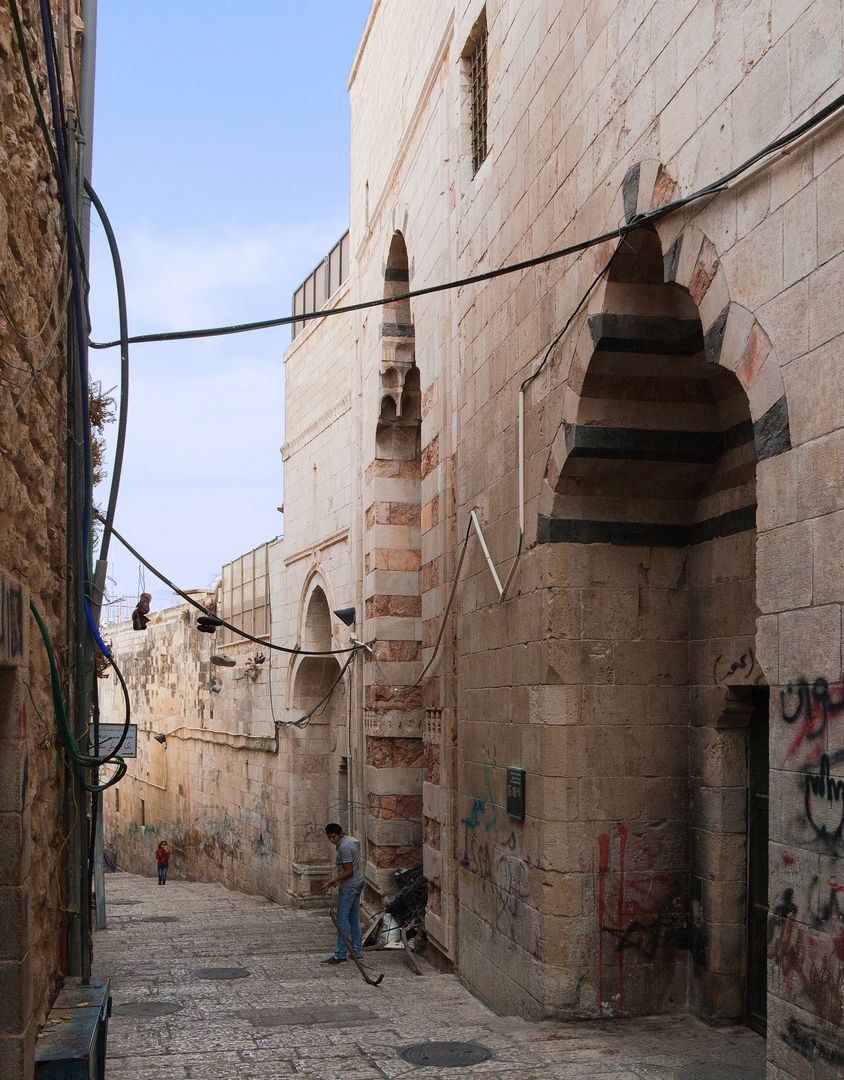Description
Property Name: Khassaki Sultan complex, Takiya Khassaki Sultan, Al-Imara al-Amira in Jerusalem
Inventory No: 972-2-17
Date of infill of the inventory form: 2020-07-23
Country (State party): Palestine
Province: Al Quds/Jerusalem
Town: Old town
Geographic coordinates: 31°46’44.46″N
35°13’57.63″E
Historic Period: Ottoman
Year of Construction: 1552 AC
Style: Ottoman
Original Use: Takiya
Current Use: Takiya
Architect: Unknown
Significance
The Khassaki Sultan complex, which is more generally known today as al-takiyya, was begun two years earlier than the more elaborate Suleymaniyye complex (962/1554-5) in Damascus but postdates the kidliye constructed by Sulaiman for his wife in Istanbul which was completed in 1539. The Khassaki Sultan complex in Jerusalem was the largest endowment in Palestine (Heyd 1960: 139) and was made possible only because of the founder’s intimate relationship with the sultan (Peri 1984: 47; see also al’ Asali 1982: 9-25). An impression of the size of the foundation and the resources it required in order to function is given by an imperial document which relates that the complex was consuming half of the entire water supply of the city (Heyd 1960: 147). To meet the requirements of both the complex and the city as a whole, another water channel had to be built, the cost of which was met by Khassaki Sultan Hurrern herself. The complex was built in and around the large Mamluk palace of al-Sitt Tunshuq which dates to c. 799/1388 (Burgoyne 1987: 485-503). The main elements of the ‘imara complex were a khan, accommodation for a Sufi community, refectory, mosque, bakery, probably a bathhouse, and a soup kitchen, which distributed two free meals daily to the poor and to the Sufi residents. Other buildings were erected to support the main functions of the complex.
Selection Criteria
ii. to exhibit an important interchange of human values, over a span of time or within a cultural area of the world, on developments in architecture or technology, monumental arts, town-planning or landscape design
iii. to bear a unique or at least exceptional testimony to a cultural tradition or to a civilization which is living or which has disappeared
vi. to be directly or tangibly associated with events or living traditions, with ideas, or with beliefs, with artistic and literary works of outstanding universal significance
State of Preservation
The hospice complex currently consists of Dar al Aytam school, carpentry, and public kitchen. The Tekke kitchen is a large hall with huge ovens, outside the kitchen and about 3 meters from its door, there is a place of light in (mutawada’s) rituals made of stone but no longer in use.
References
Natsheh, Yusuf. 2000. OTTOMAN JERUSALEM . Altajir World of Islam Trust. London
ed. Auld, Sylvia and Hillenbrand, Robert; arch. survey by Yusuf Natsheh. Ottoman Jerusalem: the living city: 1517-1917. London: Altajir World of Islam Trust, 2000.
Al-Quds, A Historical Document. Organization of the Islamic Conference.
Bahat, Dan. A selection of Ottoman Structures in the old city of Jerusalem. Jerusalem: The Open University of Israel, 1990.
Bahat, Dan. Carta’s Historical Atlas of Jerusalem, 1983
Burgoyne, Michael Hamilton. Mamluk Jerusalem, an architectural study. Scorpion Publishing Ltd., Essex, England 1987
Creswell, K.A.C. A Short Account of Early Muslim Architecture. Penguin Books, Harmondswoth, 1958.
Duncan, Alistair, The Noble sanctuary: portrait of a holy place in Arab Jerusalem. London: Longman, 1972.
Elad, Amikam. Medieval Jerusalem and Islamic Holy Places, Ceremonies, Pilgrimage. |Brill Leiden, Netherlands, 1995.
Grabar, Oleg. Jerusalem, Constructing the Study of Islamic Art, Volume IV. Ashgate Publishing Company, Hampshire, 2005.
Grabar, Oleg. The Dome of the Rock. Thames and Hudson Ltd., London, 1996.
Ed. Hattstein, Markus, Delius. Peter. Islam Art and Architecture. Könemann Verlagsgesellshaft mbH, France, 2000.
Jerusalem Institute for Israel Studies, Statistical Yearbook of Jerusalem, 2002/03
Kroyanker, David. Jerusalem Architecture. Tauris Parke Books, London, 1994.
Najm, Raip Yusuf, The Treasures of Jerusalem. Arabic Cities Organization, Al-Beti Establishment, 1983.
Sha’th, Shawqi. Al-Quds Al-Shareef. ISESCO, Rabat,1995.
Wilson, Colonel Sir Charles W. Jerusalem, The Holy City. Ariel Publishing House, Jerusalem.
Flood, F.B. 1997. Umayyad Survivals and Mamluk Revivals: Qalawunid Architecture and the Great Mosque of Damascus. Muqarnas XIV: An Annual on the Visual Culture of the Islamic World. Gülru Necipoglu (ed). Leiden: E.J. Brill, 57-79.
Grabar, Oleg. The Haram al-Sharid: An Essay in Interpretation, BRIIFS vol.2 no.2 Autumn 2000.
Jarrar, Sabri. 1998. Suq al-Ma’rifa: An Ayyubid Hanbalite Shrine in al-Haram al-Sharif. Muqarnas XV: An Annual on the Visual Culture of the Islamic World. Gülru Necipoglu (ed.) Leiden: E.J. Brill, 71-100.
Khalidi, Walid. The Dome of the Rock. Retrieved from Saudi Aramco World website: http://www.saudiaramcoworld.com/issue/199605/the.dome.of.the.rock.htm
Khoury, Nuha N.N. 1993. The Dome of the Rock, the Ka’ba, and Ghumdan: Arab Myths and Umayyad Monuments. Muqarnas X: An Annual on Islamic Art and Architecture. Margaret B. Sevcenko (ed.). Leiden: E.J. Brill.
Laurent, B. and Riedlmayer, A. Restorations of Jerusalem and The Dome of The Rock and Their Political Significance, 1537-1928
Leisten, Thomas. 1996. Mashhad Al-Nasr: Monuments of War and Victory in Medieval Islamic Art. Muqarnas Volume XIII: An Annual on the Visual Culture of the Islamic World. Gülru Necipoglu (ed.). Leiden: E.J. Brill.
Rabbat, Nasser. 1989. The Meaning of the Umayyad Dome of the Rock. Muqarnas VI: An Annual on Islamic Art and Architecture. Oleg Grabar (ed.). Leiden: E.J. Brill.
Rabbat, Nasser. 1993. The Dome of the Rock Revisited: Some Remarks on al-Wasiti’s Accounts. Muqarnas X: An Annual on Islamic Art and Architecture. Margaret B. Sevcenko (ed.). Leiden: E.J. Brill.
Richard Ettinghausen, Oleg Grabar, Marilyn Jenkins-Madina (1987),The Art and Architecture of Islam 650-1250 c.e. (pp.28-34
UNESCO, (1995) General Conference Twenty-eighth Session Report
Archnet website: archnet.org
Le Net des Etudes Françaises website: http://www.etudes-francaises.net/jerusalem/musulmane.htm#haram
Atlas of Al-Aqsa Mosque landmarks
Organization of the Islamic Conference Research Centre for Islamic History, Art and Culture
AL-QUDS/JERUSALEM IN HISTORICAL PHOTOGRAPHS: İSTANBUL, 2 0 0 9.


